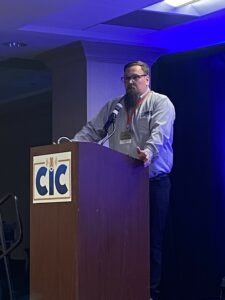
‘Uber of estimating’ is highlighted in repair plan vs. estimate discussion
By onBusiness Practices | Collision Repair | Insurance
The terms “estimate” and “repair plan” are drastically different and should not be used interchangeably in the collision repair space, a Collision Industry Conference (CIC) meeting heard.
A presentation led by DEG Administrator Danny Gredinberg and Erin Solis, with Certified Collision Group, highlighted the importance of differentiating the terms as a growing number of insurers rely on photographs alone to estimate damages.
As Gredinberg, who along with Solis serves on the CIC’s Estimating and Repair Planning Committee, noted it can be impossible to tell the true damage to a vehicle until it is fully inspected by a professional.
“Essentially, an estimate is just that: it’s to give it a quick lookover of the damage itself,” Gredinberg told conference attendees Tuesday gathered in Indiana, Indianapolis. “Truly what we are doing more and more of is a repair plan.
“A repair plan is something that requires a disassembly of the vehicle, having a staging area within your facility, having a parts cart set up to separate the damaged parts from the current parts that are being removed, [and identifying] repair procedures.”
Separately, Ryan Mandell, Mitchell’s director of claims performance, shared during the seminar how a company called Collective is using technology and gig workers to write low-severity estimates. According to Collective’s website, this is how the process works:
-
- An appraiser selects a job from the app’s dashboard;
- They then “review photos, validate car details, record damages and make repair or replace recommendations”;
- Finally, they must submit their estimate within an hour and if they don’t the job will be reassigned.
“It’s essentially the Uber of estimating,” Mandell said.
He said many of the appraisers are retired appraisers, body shop estimators or other industry professionals who were vetted by the company to ensure they have the right skills and experience to write estimates.
Those working for Collective are paid $8 per estimate and typically spend 10 minutes reviewing files before providing an estimate, Mandell said.
He added that Collective is backed by a major insurance user and is currently being used to write upward of 25,000 estimates per month.
The mere moments it takes Collective to turn in an estimate are a stark comparison to the two-and-a-half days it takes to receive a staff written estimate, or the weeks it can take for insurers to receive a direct repair program estimate, Mandell said.
“This is where there’s a benefit for the insurance carrier,” Mandell said. “The insurance carrier cannot solve the technician shortage. The insurance carrier cannot solve the supply chain issues that our industry is facing. So, they have to look and say: ‘Where can I impact the cycle time here? How can I provide a better consumer experience?’
“And by getting and creating the right set of expectations around that initial estimate and getting that to a consumer faster,” there tends to be a higher level of customer satisfaction, Mandell said, citing a JD Power study.
He said situations like these are a good example of when the term “estimate” comes into play, and that they aren’t the same as a repair plan.
“This is the true definition of an estimate,” Mandell said. “This is giving you an initial understanding of the scope of damages that is not inclusive of everything that may need to happen on that vehicle in order to bring it back to pre-loss condition.”
CIC defines an estimate on its Wiki page as “the written determination made by an appraiser or estimator, upon inspection of a damaged vehicle, regarding the cost required to restore the vehicle to the condition it was in prior to the loss.”
However, there is no definition of a repair plan on CIC’s Wiki page.
Gredinberg is calling on the collision repair community to change its terminology to improve the accuracy of insurance estimates by documenting the full extent of operations and true cost of safely and properly completing repairs.
Solis agreed.
“I think on the shop side of things we have to stop using the word estimate because it is not what we’re doing,” she said. “It’s not that that word is irrelevant anymore, it is still used, but it’s what’s happening at the beginning of the claims process on the claim side.”
Solis added: “What we’re doing as repairs is a repair plan. I think we need to keep that in mind as we move forward with what the definitions are. But for those shops in the room, it has to start with us. We have to stop using that word because it’s not what we’re doing.”
CIC’s estimate and repair planning committee is seeking the collision repair community’s input on how the repair evaluation process should be defined and is collecting feedback until Sept. 30.
Those seeking to share their perspectives can do so by emailing Gredinberg at admin@degweb.org.
Images
Featured image credit: Kwangmoozaa/iStock
DEG Administrator Danny Gredinberg
